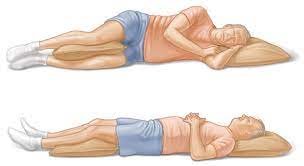Sleeping Positions
Are your sleeping positions causing you pain?
We don’t often think about our spines when we’re lying-in bed. But our sleep posture can help determine whether we experience pain.
Sleeping on your stomach is the worst position for your spine as it places the most pressure on your spine’s muscles and joints because it flattens the natural curve of your spine. Sleeping on your stomach also forces you to turn your neck, which can cause neck and upper back pain.
For pillow advice please visit out blog Which pillow is right for me? — Premier Osteopaths
Below is some of the recommended sleeping positions to help ease your pain and prevent it from coming back. So, when you turn in for the night, remember these tips.
Correct Sleeping Position: For The Lower Back
Tucking a pillow between the knees helps to keep the spine in a neutral alignment for side sleeping or sleeping on your back, like the following pictures.
Avoid sleeping on your side where one knee drops in front of the other. This twists the spine and pelvis for long periods of time as you sleep.





